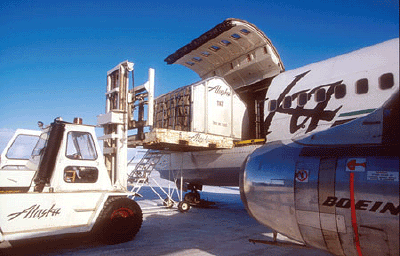Wed, Jan 12, 2005
NPRM Endorses Creation Of "All-Cargo" Security Program
 NATA says it supports a
Transportation Security Administration (TSA) proposal to address
cargo security using a risk-based approach.
NATA says it supports a
Transportation Security Administration (TSA) proposal to address
cargo security using a risk-based approach.
The TSA Notice of Proposed Rulemaking (NPRM), believed to be the
agency's first, announced formation of a new "All-Cargo" security
program for larger cargo aircraft and several other new security
initiatives for the cargo industry. "We are particularly pleased
that the TSA issued this as an NPRM, so that industry input is
received prior to implementation of new regulations. The TSA's
trend of direct to final rules appears to have finally subsided,"
explained NATA Vice President Eric R. Byer.
The association agreed with the TSA's assessment that a risk
management philosophy is the best approach to securing cargo
carried on aircraft.
"This approach recognizes that 100% screening of all cargo is
not only impractical but would cause incalculable damage to the
nation's economy," Byer said. "The layered approach to security
will allow both government and industry to direct resources to
those areas with the greatest risk that can then derive the
greatest security benefit."
For the smaller cargo carriers represented by NATA, the TSA
intends to continue compliance with the Twelve-Five Standard
Security Program (TFSSP). The NPRM proposes that any all-cargo
aircraft weighing more than 45,500 kg will comply with the new
All-Cargo program. Most all-cargo aircraft currently subject to the
TFSSP are small businesses operating as Part 135 on-demand air
carriers.
"We believe, and the TSA concurs, that the TFSSP imposes the proper
security level by recognizing that these carriers' smaller size and
operational environment create a different security risk profile
than that of the large aircraft cargo haulers," Byer said.

Of concern to NATA was a proposed expansion of security areas,
known as SIDAs, to include cargo areas at certain airports already
subject to security regulations. NATA believes the costs for this
proposal and the potential safety impacts for nearby general
aviation areas have not been adequately considered by the TSA.
NATA's comments also suggested some changes to the proposed
rules to clarify the regulatory intent and prevent confusion within
the industry.
More News
Also: Pratt & Whitney 747SP, Gratia Aero, Robinson/MagniX, Jack Pelton Part5 The Avidyne Vantage 12 is finally certified and will shortly be shipping out so that aging Cirrus a>[...]
Aero Linx: Army Aviation Medicine Association (AAVMA) The Society of US Army Flight Surgeons (SoUSAFS) serves to advance the science and art of Aerospace Medicine and its allied sc>[...]
Witnesses Reported That They Heard A Loss Of Engine Power Analysis: Witnesses reported that the airplane departed from runway 35 after a successful runup. During the initial climb,>[...]
Radio Magnetic Indicator An aircraft navigational instrument coupled with a gyro compass or similar compass that indicates the direction of a selected NAVAID and indicates bearing >[...]
"After exiting, I had a vague recollection of what just happened…and a much clearer view of how quickly hypoxia can sneak up. Sign-ups for PROTE are open each day of AirVent>[...]
 OSH25 Day 5 Redux: Avidyne Vantage 12, Is Fly-Inn An AeroBnB?, B25 Miss Mitchell
OSH25 Day 5 Redux: Avidyne Vantage 12, Is Fly-Inn An AeroBnB?, B25 Miss Mitchell ANN's Daily Aero-Linx (07.29.25)
ANN's Daily Aero-Linx (07.29.25) NTSB Final Report: Curtiss Wright P-40E
NTSB Final Report: Curtiss Wright P-40E ANN's Daily Aero-Term (07.29.25): Radio Magnetic Indicator
ANN's Daily Aero-Term (07.29.25): Radio Magnetic Indicator Aero-News: Quote of the Day (07.29.25)
Aero-News: Quote of the Day (07.29.25)




